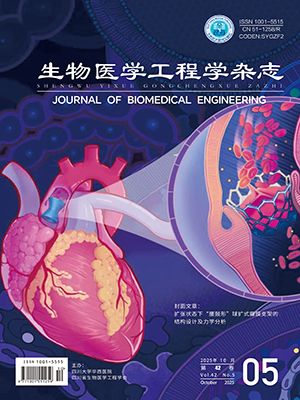| 1. |
Andreasen D, Edmund J M, Zografos V, et al. Computed tomography synthesis from magnetic resonance images in the pelvis using multiple random forests and auto-context features//Medical Imaging 2016: Image Processing. San Diego: SPIE, 2016, 9784: 323-330.
|
| 2. |
Yang X, Lei Y, Shu H K, et al. Pseudo CT estimation from MRI using patch-based random forest//Medical Imaging 2017: Image Processing. San Diego: SPIE, 2017, 10133: 775-782.
|
| 3. |
Chen Z, Qiu T, Tian Y, et al. Automated brain structures segmentation from PET/CT images based on landmark-constrained dual-modality atlas registration. Physics in Medicine & Biology, 2021, 66(9): 095003.
|
| 4. |
Newton M D, Junginger L, Maerz T. Automated MicroCT-based bone and articular cartilage analysis using iterative shape averaging and atlas-based registration. Bone, 2020, 137: 115417.
|
| 5. |
Goodfellow I, Pouget-Abadie J, Mirza M, et al. Generative adversarial networks. Communications of the ACM, 2020, 63(11): 139-144.
|
| 6. |
Nie D, Trullo R, Lian J, et al. Medical image synthesis with deep convolutional adversarial networks. IEEE Transactions on Biomedical Engineering, 2018, 65(12): 2720-2730.
|
| 7. |
Dar S U, Yurt M, Karacan L, et al. Image synthesis in multi-contrast MRI with conditional generative adversarial networks. IEEE Transactions on Medical Imaging, 2019, 38(10): 2375-2388.
|
| 8. |
Zhu J Y, Park T, Isola P, et al. Unpaired image-to-image translation using cycle-consistent adversarial networks//IEEE International Conference on Computer Vision (ICCV), Venice: IEEE. 2017, 24: 2242-2251.
|
| 9. |
Jin C B, Kim H, Liu M, et al. Deep CT to MR synthesis using paired and unpaired data. Sensors, 2019, 19(10): 2361.
|
| 10. |
Peng Y, Chen S, Qin A, et al. Magnetic resonance-based synthetic computed tomography images generated using generative adversarial networks for nasopharyngeal carcinoma radiotherapy treatment planning. Radiotherapy and Oncology, 2020, 150(3): 217-224.
|
| 11. |
Fetty L, Löfstedt T, Heilemann G, et al. Investigating conditional GAN performance with different generator architectures, an ensemble model, and different MR scanners for MR-sCT conversion. Physics in Medicine & Biology, 2020, 65(10): 105004.
|
| 12. |
Wang J, Wu Q M J, Pourpanah F. DC-cycleGAN: bidirectional CT-to-MR synthesis from unpaired data. Computerized Medical Imaging and Graphics, 2023, 108: 102249.
|
| 13. |
Wolterink J M, Dinkla A M, Savenije M H F, et al. Deep MR to CT synthesis using unpaired data//Simulation and Synthesis in Medical Imaging: Second International Workshop. Québec: MICCAI, 2017: 14-23.
|
| 14. |
蔡昕, 侯学文, 杨光, 等. 生成对抗网络在磁共振图像重建领域的应用. 生物医学工程学杂志, 2023, 40(3): 582-588.
|
| 15. |
Bi L, Kim J, Kumar A, et al. Synthesis of positron emission tomography (PET) images via multi-channel generative adversarial networks (GANs). Lecture Notes in Computer Science, 2017, 1055: 43-51.
|
| 16. |
Chartsias A, Joyce T, Dharmakumar R, et al. Adversarial image synthesis for unpaired multi-modal cardiac data//Simulation and Synthesis in Medical Imaging: Second International Workshop. Québec: MICCAI, 2017: 3-13.
|
| 17. |
Kingma D P, Welling M. An introduction to variational autoencoders. Foundations and Trends® in Machine Learning, 2019, 12(4): 307-392.
|
| 18. |
Liu M Y, Breuel T, Kautz J. Unsupervised image-to-image translation networks. Advances in Neural Information Processing Systems, 2017, 30(3): 5-11.
|
| 19. |
Li Y, Shao H C, Qian X, et al. FDDM: unsupervised medical image translation with a frequency-decoupled diffusion model. arXiv preprint, 2023, arXiv: 2311.12070.
|
| 20. |
潘丹, 贾龙飞, 曾安, 等. 生成式对抗网络在医学图像处理中的应用. 生物医学工程学杂志, 2018, 35(6): 970-976.
|
| 21. |
Dhariwal P, Nichol A. Diffusion models beat gans on image synthesis. Advances in Neural Information Processing Systems, 2021, 34: 8780-8794.
|
| 22. |
Ho J, Jain A, Abbeel P. Denoising diffusion probabilistic models. Advances in Neural Information Processing Systems, 2020, 33: 6840-6851.
|
| 23. |
Meng C, Song Y, Song J, et al. Sdedit: image synthesis and editing with stochastic differential equations. arXiv preprint, 2021, arXiv: 2108.01073.
|
| 24. |
Zhao M, Bao F, Li C, et al. EGSDE: unpaired image-to-image translation via energy-guided stochastic differential equations. Advances in Neural Information Processing Systems, 2022, 35: 3609-3623.
|
| 25. |
Özbey M, Dalmaz O, Dar S U H, et al. Unsupervised medical image translation with adversarial diffusion models. IEEE Transactions on Medical Imaging, 2023, 42(12): 3524-3539.
|
| 26. |
Li Y, Shao H C, Liang X, et al. Zero-shot medical image translation via frequency-guided diffusion models. IEEE Transactions on Medical Imaging, 2023, 43(3): 980-993.
|
| 27. |
Jiang L, Dai B, Wu W, et al. Focal frequency loss for image reconstruction and synthesis//Proceedings of the IEEE/CVF International Conference on Computer Vision. Montreal: IEEE, 2021: 13919-13929.
|
| 28. |
Xiao Z, Kreis K, Vahdat A. Tackling the generative learning trilemma with denoising diffusion gans. arXiv preprint, 2021, arXiv: 2112.07804.
|
| 29. |
Shannon M, Poole B, Mariooryad S, et al. Non-saturating GAN training as divergence minimization. arXiv preprint, 2020, arXiv: 2010.08029.
|
| 30. |
Thummerer A, van der Bijl E, Galapon Jr A, et al. SynthRAD2023 Grand Challenge dataset: generating synthetic CT for radiotherapy. Medical Physics, 2023, 50(7): 4664-4674.
|




